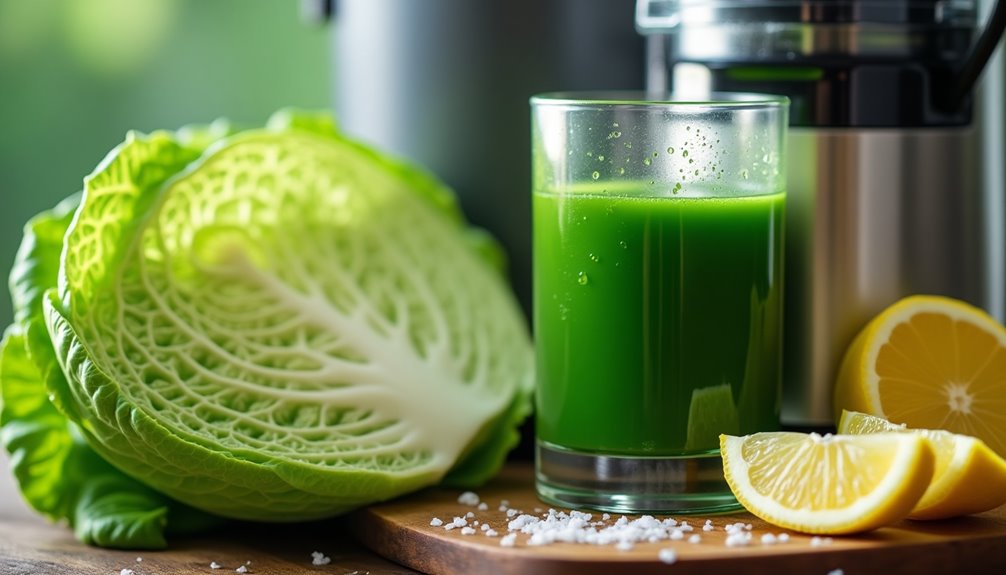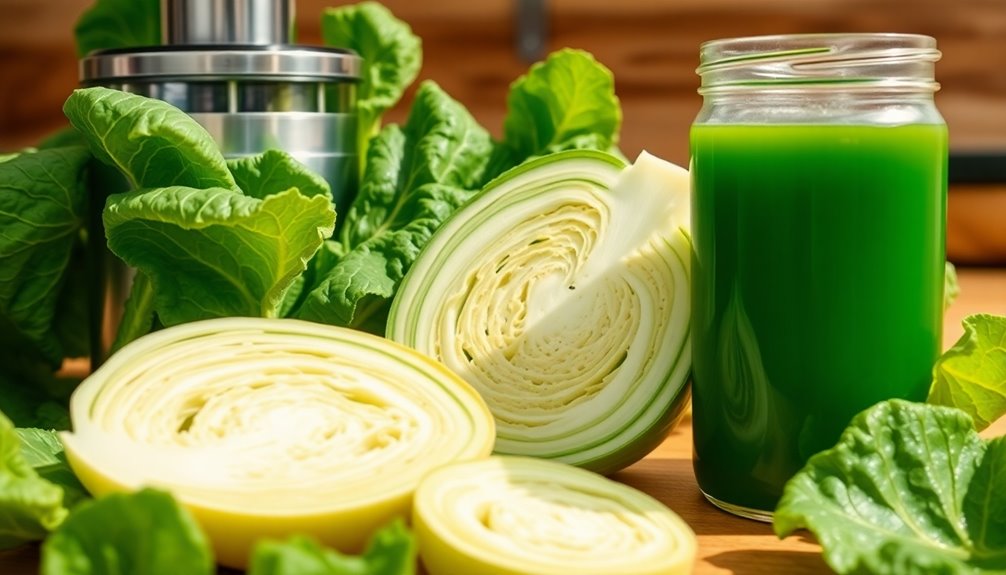To make cabbage juice for acid reflux, take a fresh head of green cabbage and chop it into small pieces. Blend it with a bit of water until smooth, then strain the mixture through a nut milk bag or fine mesh strainer to extract the juice. Aim to drink about 8 ounces daily for best results. You can enhance the flavor by adding celery or carrots. There's more to learn about the benefits and preparation techniques!
Key Takeaways
- Select a fresh head of green cabbage and chop it into smaller pieces for easier blending.
- Blend the chopped cabbage with a little water until smooth, or use a juicer for concentrated juice.
- Strain the mixture through a nut milk bag or fine mesh strainer to separate the juice from the pulp.
- Enhance flavor and nutrition by adding carrots or celery to balance the bitterness of cabbage.
- Aim to consume about 8 ounces of fresh cabbage juice daily for potential relief from acid reflux symptoms.

If you're struggling with acid reflux, consider making cabbage juice as a natural remedy. This vibrant juice not only boasts anti-inflammatory properties but also helps protect your stomach lining. Drinking cabbage juice regularly may provide relief from acid reflux symptoms and promote overall digestive health. By incorporating this simple drink into your routine, you could potentially enhance your well-being significantly.
To make cabbage juice, start by selecting a fresh head of cabbage. The type of cabbage you choose can make a difference; green cabbage is commonly recommended for its health benefits. Once you have your cabbage, chop it into smaller pieces to make the blending process easier. In a blender, combine the chopped cabbage with a little water for smooth blending. The water helps create a more fluid mixture, allowing you to separate the juice effectively later on. If you have a juicer, you could use that instead, as it’ll streamline the process and yield a more concentrated juice. After blending or juicing, strain the mixture using a fine mesh sieve or cheesecloth to extract the liquid while leaving the pulp behind. This step is crucial for achieving a smooth texture in your cabbage juice. If you’re looking for guidance on how to prepare cabbage juice, you can also experiment with adding other ingredients like lemon or ginger for added flavor and health benefits. Enjoy your nutritious drink chilled or at room temperature!
After blending, it's time to separate the juice from the pulp. You can do this by pouring the mixture through a nut milk bag or a fine mesh strainer. This step ensures you get the pure juice without any fibrous bits. It's essential to drink the juice as soon as possible for maximum health benefits. Freshly made cabbage juice contains valuable nutrients like vitamin C, which can help heal stomach ulcers and contribute to great health overall.
For added flavor and nutrition, consider blending in other ingredients like celery or carrots. These additions not only enhance the taste but also provide additional vitamins and minerals that can further aid your digestive system. You might find that the sweetness of carrots balances out the cabbage's natural bitterness, making the juice more enjoyable.
After you make cabbage juice, aim to drink about 8 ounces daily. This dosage has been linked to alleviating acid reflux symptoms and may help heal peptic ulcers over time. Drinking cabbage juice regularly can also be beneficial if you're dealing with other gastrointestinal issues. Just remember that consistency is key; incorporating this juice into your daily routine is crucial for experiencing its full benefits.
If you need to store the juice, keep it in the refrigerator for up to three days. While it's best to consume it fresh, having it on hand can ensure you don't miss out on its potential benefits. Just be sure to give it a good shake before drinking, as separation can occur.
Frequently Asked Questions
Is Raw Cabbage Juice Good for Acid Reflux?
Raw cabbage juice can be beneficial for acid reflux.
It's packed with vitamin U, which may help reduce inflammation and protect your stomach lining. Drinking about 8 to 10 ounces daily could support your digestive health and alleviate discomfort.
Plus, its vitamin C content might help prevent H. pylori infections that can worsen gastric issues.
However, it's wise to consult a healthcare professional before adding it to your diet, especially if you have health concerns.
How Long Does It Take for Cabbage Juice to Heal GERD?
Picture a garden thriving under the sun, vibrant and full of life.
In just about nine days, you could experience noticeable improvements in your stomach's healing by incorporating cabbage juice into your routine. As you sip on this green elixir daily, you might find its healing properties, fueled by Vitamin U, working to alleviate your GERD symptoms.
How Do You Make Your Own Cabbage Juice?
To make your own cabbage juice, start by rinsing and chopping a head of cabbage into 1-inch chunks.
Blend the chunks with a bit of water until smooth.
Strain the mixture through a nut milk bag or mesh sieve to get the juice, discarding any pulp.
For a flavor boost, consider adding celery, cucumber, or fruits like apple or lemon.
Can I Boil Cabbage and Drink the Juice?
Imagine a pot bubbling away like a cauldron of health. Yes, you can boil cabbage and drink the juice!
Just chop the cabbage, boil it in water for about 30 minutes, and strain the liquid. While boiling can diminish some vitamins, you still get benefits from its anti-inflammatory properties.
To maximize nutrients, drink it promptly. If you've got any digestive concerns, it's wise to consult a healthcare professional before diving in.
Conclusion
Incorporating cabbage juice into your routine can be a soothing remedy for acid reflux. Picture yourself sipping the vibrant green elixir, its fresh, crisp flavor washing over your palate, while the nutrients work gently to calm your stomach. With each gulp, you're not just nourishing your body, but also embracing a simple, natural solution. So, grab that head of cabbage and blend your way to relief—your tummy will thank you, and you'll feel lighter and more at ease.
Cindy thoroughly researches juicing trends, techniques, and recipes to provide readers with practical advice and inspiration. Her writing style is accessible, engaging, and designed to make complex concepts easy to understand. Cindy’s dedication to promoting the advantages of juicing shines through her work, empowering readers to make positive changes in their lives through the simple act of juicing.











